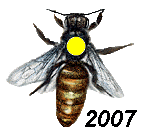|
Utah Beekeepers' Association
Serving and Representing Utah's Beekeepers Since 1872; As Currently Organized since 1892.
Mission Statement: Our aim is to keep beekeepers in the state of Utah informed about what is happening in the industry; to promote beekeeping and honey production for all Commercial, Sideliner and Hobbyist Beekeepers.
Queen Rearing and Bee Breeding
It is common practice to mark the queen with a small spot of paint on her back (thorax). A color code exists within the beekeeping industry to indicate the year the queen was introduced.
 |
Color: | For Years Ending In: |
| White or Grey | 1 or 6 | |
| Yellow | 2 or 7 | |
| Red | 3 or 8 | |
| Green | 4 or 9 | |
| Blue | 5 or 0 |
A paint pen, model car paint, or fingernail polish may be used to mark the queen. The identifying mark should be small, so that it does not cover any other part of the queen. A 1/16" stick, lightly dipped in paint, is a good applicator if you don't have a paint pen. Generally, queens are marked before being introduced. They can; however, be marked at any time. Paint should be given ample time to dry before the queen is released into the colony. In fact, queens may be purchased already marked by the queen producer.
Some beekeepers also identify queens by clipping the tip of the tip of one forewing. If queens are replaced every two years, the beekeeper clips the left wing(s) on queens introduced in odd years, and the right on queens introduced in even years. The clipping practice may also supplement the paint spot technique as a back-up should the queen lose her paint mark. If clipped correctly, the queen will not be able to fly. However, if clipped too closely, the queen may appear damaged and be superseded.
See also Queen Catching and Marking.
